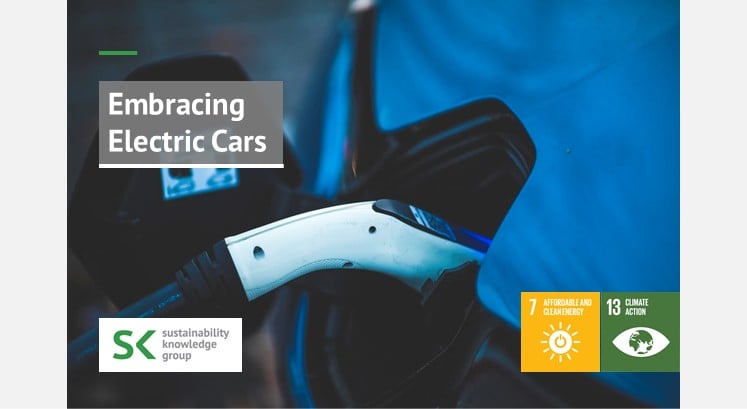With the increase in environmental pollution and climate change, the need for innovative solutions and technologies increases in a variety of industries, including the automotive industry. In the past decade, the popularity and demand for electric vehicles (EVs) have accelerated. China and Europe both hit sale records in market share for EVs in 2019. In 2040, EVs are expected to account for more than half of the cars sold (about 54%) in the world.
EVs are directly aligned with the United Nations’ global Sustainable Development Goals (SDGs), especially SDG 7: Clean Energy and also pave the way for action on SDG 13: Climate Action for a low carbon future.
No diesel and gasoline vehicles after this date
Significantly, China and Europe are promoting national and local support plans for EVs use. The Chinese government strongly supports EVs to achieve the goal of 5 million EVs on China’s roads by 2020.
The main policies of the Chinese central government to promote EVs include the following:
- Zero emissions vehicle mandate: each Chinese vehicle manufacturer and importer is required to make or import at least 10% EVs.
- Subsidies: the Chinese government provides subsidies to manufacturers of EVs. All subsidies for the manufacture of plug-in EVs are scheduled to be eliminated in 2021.
- Tax exemptions: the Chinese government exempts EVs from consumption and sales taxes.
- Procurement: the Chinese government also uses its procurement power to promote EVs.
- New auto factory requirements: any new vehicle factory is required to include capacity for the construction of EVs.
- Support for charging infrastructure: the Chinese central government promotes the development of EV charging infrastructure as a matter of national policy. Its targets include: 120,000 EV charging stations and 4.8 million EV charging posts by 2020.
Although China is the largest market for EVs in the world, the situation in Europe looks positive. In 2019, the proportion of EVs on China’s roads was only 5.2%, while 56% of vehicles on Norway’s roads were electric.
Actions vary at the national and local levels to support the deployment of electric vehicles across European countries. Most European countries have adopted:
- Financial incentives to bridge the cost gap between electric and conventional cars
- Programs to deploy charging infrastructure information campaigns to raise awareness and increase visibility regarding available EVs and their benefits.
- National and local one-time purchase subsidies and annual national tax breaks on vehicle registration and operation
- Discounts or exemptions on parking fees or parking permits, charging an EVs, road tolls, and congestion charges
- Different local and national programs in place that support home and workplace charging
United Kingdom, France, Portugal, announced that they would ban the sale of new diesel and gasoline powered cars by 2040, and switch to EVs to reduce carbon emissions. A few days ago, the British government announced that in order to accelerate the transition it will ban diesel and gasoline powered cars by 2030, joining Sweden and Denmark, which will ban them also in 2030.
The British government will spend around £12 billion on the plan, including £1.3 billion to accelerate the deployment of charging points for EVs in homes, streets and on highways. About £582 million will help people afford low-emission vehicles, and nearly £500 million will be spent in the next four years developing and mass- scale EV batteries.
Especially for EU counties, the European Directive 2014/94/EU on the deployment of alternative fuels, urges Member States to implement charging points for electric vehicles (at least one station per 10 EVs) and many countries have announced the development of National Strategies for Electric Vehicles promoting innovative solutions. However, there is still great divergence among national rules and regulations.
Automakers
Automakers are accelerating plans to launch EVs as part of their climate commitments and to meet policy requirements. Whereas the increasingly strict regulations in some countries, which are limited to the use of EVs, will contribute to reducing the number of buyers of gasoline and diesel cars. In 2019, the EV industry saw sales of more than 2.1 million vehicles globally, with an annual increase of 40%.
In addition to new EV makers such as Tesla Inc. and Rivian Automotive Inc., the world’s leading automakers also shift to the production of EVs. Ford Motor Co., General Motors Co. and Volkswagen AG focus on launching EVs and the total investments announced by global manufacturers for North America between 2020 and 2025 is estimated at US$300 billion.
Challenges and concerns
EVs are still more expensive compared to other vehicles. It is estimated that the average EV battery can currently cost approximately US $16,000, plus the EV manufacturing costs about $10,000 more than gasoline cars. Although the switch to electric cars is very ambitious, it is a huge and expensive undertaking. Countries need to be financially prepared for such a rapid transformation, as it requires massive investment in the required infrastructure for EVs. Further issues arise related to subsidies, incentives and affordability. Despite the challenges, one thing is certain: the electric vehicle came to stay.
Photo by Markus Spiske on Unsplash

